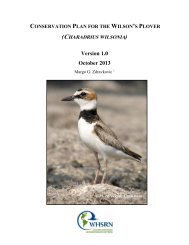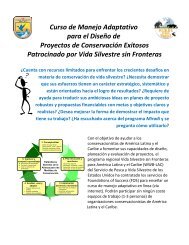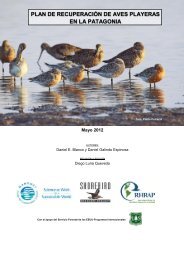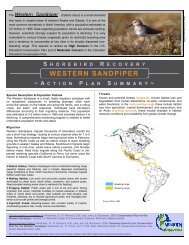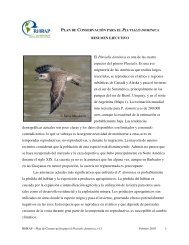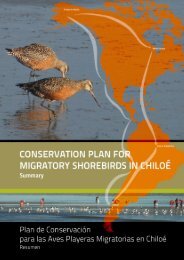Sanderling Plan - Western Hemisphere Shorebird Reserve Network
Sanderling Plan - Western Hemisphere Shorebird Reserve Network
Sanderling Plan - Western Hemisphere Shorebird Reserve Network
Create successful ePaper yourself
Turn your PDF publications into a flip-book with our unique Google optimized e-Paper software.
flyway-scale monitoring scheme for the <strong>Sanderling</strong> and other shorebirds (during<br />
migration and winter);<br />
o Quantify relationship between counts and population estimates;<br />
o Determine lengths of stay (turnover rates) at stopover areas to permit calculation of<br />
population estimates;<br />
o Estimate the extent to which populations have declined;<br />
o What factors drive population trends? (need data from South America and from Atlantic<br />
Coast wintering populations).<br />
Population separation and overlap:<br />
o To what extent do birds mix or segregate between breeding populations, migration routes,<br />
and wintering areas? Identify any population-specific needs.<br />
Variability among populations:<br />
o How much variability (in mating systems, reproductive behavior, timing, migration<br />
distance, etc.) exists among and within populations?<br />
WINTERING GROUNDS<br />
The <strong>Sanderling</strong> has an extensive wintering range throughout the Americas. It is the most<br />
common shorebird along most of the Pacific coast of South America (from the equator<br />
southward), and occurs along many sandy beaches between Peru and Chile. However, with few<br />
exceptions (i.e., parts of California), <strong>Sanderling</strong>s are poorly studied on their wintering grounds.<br />
Important areas for research include understanding the distribution of age and sex classes during<br />
winter; and understanding habitat use, site fidelity, and flexibility to adapt to new sites during<br />
winter.<br />
MIGRATION<br />
Timing and routes: Migration routes and schedules are closely timed with seasonally<br />
abundant food resources. How flexible are migration routes?<br />
WHSRN – <strong>Sanderling</strong> Conservation <strong>Plan</strong>, February 2010, v1.1 62





